
Pilots of the Orеl Region – Heroes of the Great Patriotic War
Many severe trials have befallen our people, many heroic deeds have they performed for their native land. But they have never shown such mass heroism, steadfastness, courage, as during the Great Patriotic War.
Natives of the Orеl region fought on all fronts and in all branches of the armed forces ... The defense of Moscow, Leningrad and Sevastopol, the Battle of Stalingrad and the Orеl-Kursk Bulge…
The highest degree of distinction of feats is considered to be the title of Hero of the Soviet Union. One hundred and seventy-nine natives of the Orеl region were awarded this title during the war of 1941-1945. Thirty-five Orеl residents were awarded this title for crossing the Dnieper, twenty-eight – for the liberation of Belarus, twenty – for fighting in Poland, seven – for crossing the Oder, eleven - for participating in the storming of Berlin.
There are thirty-eight pilots among the heroes of Orеl.
Georgy Mikhailovich Parshin became a Hero of the Soviet Union twice.
Georgy Parshin served on the fronts of the Great Patriotic War since January 1942 as a pilot of the 65th Assault Aviation Regiment (Central Front). In 1943, he graduated from officer training courses and was sent to the Leningrad Front as a squadron commander of the 943rd Assault Aviation Regiment.
From besieged Leningrad, Georgy Parshin repeatedly flew sorties for reconnaissance and assault strikes on long-range enemy guns. With the beginning of the offensive of the Leningrad Front, he and his comrades carried out an assault on enemy positions, destroyed guns and tanks. Only during the first day of the offensive, he made 5 sorties.
|
Parshin George Mikhailovich (23. 05.1916 – 13.03.1956) (39 years old)
He was born in the village of Setukha (Zalegoshchensky district of the Oryol region) in a peasant family. |
Twice Hero of the Soviet Union, commander of the 943rd Assault Aviation Regiment, Major, test pilot
He was awarded two Gold Star medals and the Order of Lenin, 4 Orders of the Red Banner, the Orders of Suvorov of the 3rd degree, Alexander Nevsky, the Patriotic War of the 1st degree and many medals. |
The Chief Marshal of Aviation called him a "virtuoso of assault strikes". He made 253 sorties, shot down 10 enemy aircraft, destroyed many defensive structures, equipment and enemy manpower.
After the war, he continued to serve in aviation. He died in 1956 in the line of duty. |
When flying out to attack a large group of tanks, during the battle the squadron was attacked by enemy aircraft. Parshin's plane was shot down and could not reach the front line, fell on the forest. Parshin and his shooter Bondarenko managed to jump out of the burning plane.
Upon returning to the regiment, Georgy Parshin received a new aircraft, which was purchased at the expense of the Leningrad Barinovs. On the left side of the plane was written "Revenge of the Barinovs", on the right — "For Leningrad!". In the first flight on the new plane, Parshin shot down an enemy plane. By March 1944, Major Parshin had made 138 sorties to attack enemy manpower and equipment.
He was awarded the title of Hero of the Soviet Union on August 9, 1944. For the subsequent 96 sorties and 10 downed enemy aircraft on April 19, 1945, he was awarded the second Gold Star medal. During the battles for the liberation of Estonia, Parshin was appointed commander of an aviation assault regiment. Georgy Parshin ended the war near Konigsberg: he covered the landing on the spit, stormed sea and land targets.
After the war, he worked as a pilot in the transport detachment of the Ministry of Aviation Industry. In 1950, he began working as a test pilot at Aviation Plant. In 1952, he joined the Research Institute of Aircraft Equipment, tested various systems and equipment. On March 13, 1956, when testing the Il-28 aircraft, he died. He was buried in Moscow at the Vagankovsky Cemetery.
In the homeland of the twice hero, a bronze bust is installed in the district center of the village of Zalegoshch. In Moscow, one of the streets is named after him.
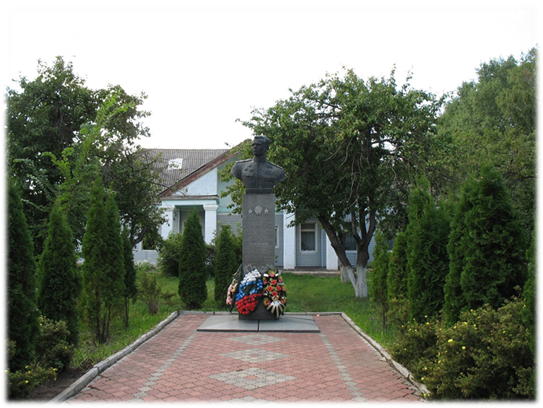
Ivan Antonovich Leonov is another of our countrymen, the only pilot in the world during the Great Patriotic War who flew a combat aircraft without one arm (listed in the Guinness Book of Records).
In the battles of the Great Patriotic War since 1943. Since May 6, 1943 – as a pilot of the 192nd Fighter Aviation Regiment of the 6th Fighter Aviation Corps. He fought on the Kursk Bulge, where he opened his combat account by shooting down an enemy bomber "Yu-88" in the sky over Kursk.
By mid-July 1943, the fighter pilot of the fighter aviation regiment had made 50 sorties, shot down 5 enemy aircraft.
On July 15, 1943, while escorting bombers near the city of Orel, a group of our fighters was attacked by enemy fighters. With a decisive and bold attack, I. A. Leonov shoots down the leader of a group of enemy fighters. The rest of the fighters scattered in panic and did not try to make an attack anymore, which made it possible for our fighters to perform a combat mission. Lieutenant Leonov's plane was shot down, and the pilot himself was seriously wounded in the left arm and a shrapnel wound to the chest. An enemy shell shattered the pilot's shoulder joint.
Military medics saved the brave pilot's life, but his left arm and shoulder blade were amputated. Ivan Leonov was 20 years old.
|
Leonov Ivan Antonovich (1.021923 – 21. 06.2018) (95 years old) He was born in the village of Mogovka in the Shablykinsky district of the Oryol region in a large peasant family. |
The only pilot in the world who flew a combat aircraft without one arm during the Great Patriotic War (listed in the Guinness Book of Records).
Shot down 2 enemy aircraft, was shot down himself, received a severe wound to the left shoulder joint, which resulted in a complete amputation of the arm. |
On the Central Front, from May 6 to July 5, 1943, he made 10 successful combat sorties. On the Kursk Bulge, on July 5, 1943, accompanied by PE-2 bombers in the Ponyri area, Leonov shoots down the leading group of enemy fighters with a decisive and bold attack. |
After being discharged from the hospital, Leonov applied for permission to fly again. On airplanes of those times, the left hand performed only one function: it worked with the throttle lever. I. Leonov said: "At first I decided to transfer this function to the foot, to make a pedal like in a car. It didn't work out. I was terribly upset. Suddenly it dawned on me: after all, you can pull your shoulder! I found a piece of aluminum, made a shoulder pad to reach the lever, with a grip at the end. The grip snapped on the lever, and I used my shoulder to push or release the gas."
Having become disabled, the young officer managed to convince the commander of the 1st Air Army, by way of exception, to leave him on a flight job at a personal meeting. Subsequently, he flew with a prosthesis of his own design instead of an arm.
I. A. Leonov was presented with the title Hero of the
Soviet Union during the war, but did not receive the award, since after signing
the decree he was considered dead.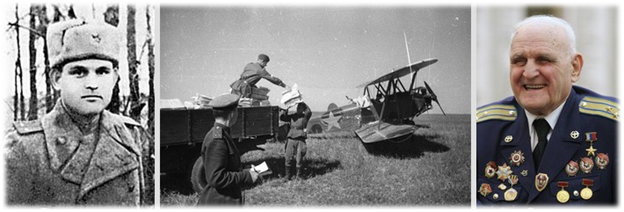
In 1995, on the anniversary of the Victory, at the Armavir Military Aviation Institute, pilots learned about the unusual fate of their humble graduate. The leaders of the school found I. A. Leonov, raised the archives and ensured that the feat of the brave pilot was appreciated.
"For the courage and heroism shown in the fight against the Nazi invaders in the Great Patriotic War of 1941-1945," retired Senior Lieutenant Leonov Ivan Antonovich was awarded the title of Hero of the Russian Federation by Presidential Decree No. 147 of February 16, 1995 with the award of the Gold Star medal.
Marina Pavlovna Chechneva is a native of the Orel region, a pilot, Hero of the Soviet Union. During the Great Patriotic War, she commanded a squadron of the 46th Taman Guards Night Light Bombardment Regiment, Guards Major.
With the beginning of the Great Patriotic War, she sought conscription into the Red Army and sent to the front. As a result, she was sent as an instructor pilot to the V. P. Chkalov Central Aero Club, relocated from Moscow to Stalingrad. At the beginning of 1942 – as part of the 588th aviation regiment of night bombers.
|
Chechneva Marina Pavlovna (15. 08.1922 – 12.01.1984) (62 years old) Was born in Protasovo village, Maloarkhangelsky district, Orel region in a worker's family.
|
She was awarded 2 Orders of the Red Banner, the Order of the Patriotic War of the 1st and 2nd degrees, 3 Orders of the Red Star, many medals, and also awarded the title of Hero of the Soviet Union with the award of the Order of Lenin and the Gold Star medal. |
In total, during the war years, Marina Chechneva made 810 sorties, spent more than a thousand combat hours in the air, dropped over 115 tons of combat cargo on the enemy, destroyed 6 warehouses, 5 crossings, 1 railway echelon, 1 aircraft, 4 searchlights, 4 anti-aircraft batteries. In addition, she has trained 40 pilots and navigators. |
In August 1942 Marina Chechneva became a flight commander. Participated in the defense of the Caucasus. On September 27, 1942, she was awarded the Order of the Red Banner. On February 8, 1943, the 588th Aviation Regiment received the rank of Guards and was renamed the 46th Guards, and a little later received the honorary name "Tamansky".
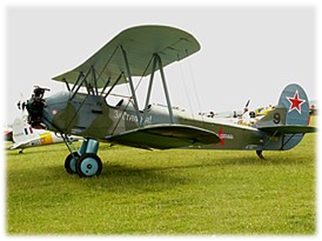
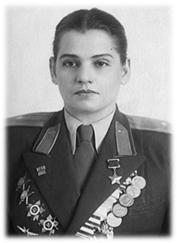
At the end of the summer of 1943, Marina Chechneva became the commander of the 4th squadron of the regiment. Participated in the liberation of the Crimean Peninsula. From May 15, 1944, as part of the 325th Night Bomber Aviation Division of the 4th Air Army of the 2nd Belorussian Front, she took part in the liberation of Belarus, the battles for East Prussia. At the end of February 1945 Marina Chechneva received the second Order of the Red Banner. She met the victory near the town of Svinemunde (now Svinoujscie). In November 1945, after the disbandment of the aviation regiment, Marina Chechneva remained to serve in an assault regiment in Poland. In 1949, after moving to her homeland, she set a speed record on a Yak-18 sports plane. For a long time she was the leading female aerobatic team at air parades. She has flown many types of aircraft, including: Yak-3, Yak-9, Yak-11, Yak-18T. She had the honorary title of Honored Master of Sports of the USSR.
Nadezhda Vasilyevna Popova – Hero of the Soviet Union, Deputy squadron commander of the 46th Guards Women's Regiment of night bombers of the 4th Air Army of the 2nd Belorussian Front. The nickname "Night Witch".
In 1936, after completing her studies at the secondary school of the city of Stalino (now Donetsk, Russia), she entered the aero club, which she graduated from in 1937, and was left there for further training as an instructor.
In 1939, she came to Moscow in order to become a military pilot. In 1940, she continued her studies at the Donetsk Military Aviation School and received a diploma as a pilot-navigator. While serving as an instructor of the aero club, she trained 2 groups of pilots – 15 people each.
With the beginning of the Great Patriotic War, the instructor of the primary training of the military aviation school, Nadezhda Popova, evacuated with the educational institution to the city of Kattakurgan, Samarkand region of Uzbekistan, where she trained fighter pilots for front-line aviation, and wrote reports on sending to the front. Nadezhda Popova asked to join a regiment of light-engine night bombers.
In May 1942, upon completion of the reduced training program, Petty Officer Popova flew to the front as part of the 588th Bomber Night Women's Aviation Regiment. The flight commander Popova led the flight to night bombing in the Taganrog, Rostov-on-Don area. She often flew out for daytime reconnaissance. It was shot down, burned.
|
Popova Nadezhda Vasilyevna (17.12.1921 — 607.2013) (92 years old) Was born in the village of Shabanovka, (now Dolzhansky district, Orel region) in a worker's family |
By the decree of the Presidium of the Supreme Soviet of the USSR dated February 23, 1945, the deputy commander of the squadron of the Guard, Captain Popova Nadezhda Vasilyevna, was awarded the title Hero of the Soviet Union for bravery and heroism shown in battles with the Nazi occupiers, with the award of the Order of Lenin and the Gold Star medal. |
During the years of the Great Patriotic War, she made 852 combat sorties. The flight commander Popova led the flight to night bombing in the Taganrog, Rostov-on-Don area. She often flew out for daytime reconnaissance. Her plane was shot down, burned. Masterfully maneuvering, she left the searchlights and anti-aircraft guns, bombed the crossings on the Terek and Sunzha. The Fascists had given her the nickname "Night Witch" |
During the fighting in the North Caucasus, Popova's unit flew out on combat missions several times a night. Masterfully maneuvering, they left the searchlights and anti-aircraft guns, bombed the crossings on the Terek and Sunzha. For exemplary performance of tasks, Lieutenant Popova was awarded the first Order of the Red Banner. Noting the military merits of Soviet pilots, in the winter of 1943, at the height of the fighting in the Kuban, the 588th regiment was awarded the title of Guards.
Pilots of the Guards Women's regiment of night bombers fought in Ukraine, Crimea, Belarus, Poland and on the territory of Nazi Germany. In total, during the years of the Great Patriotic War, she made 852 combat sorties.
Decree of the Presidium of the Supreme Soviet of the USSR dated February 23, 1945 No. 4858 to the deputy commander of the squadron of the Guard, Senior Lieutenant Popova Nadezhda Vasilyevna "for exemplary performance of combat missions of the command at the front of the fight against the German invaders and the courage and heroism shown at the same time" was awarded the title Hero of the Soviet Union with the award of the Order of Lenin and the Gold Star medal.
Until 1952, she served in the Armed Forces of the USSR, retiring to the reserve with the rank of major. Honorary citizen of Donetsk, Honored Worker of Culture of the RSFSR, member of the Presidium of the Council for Interaction with Public Associations of Veterans under the President of the Russian Federation. Since 1975, she has been the permanent head of the public commission for youth work under the Russian Committee of War Veterans and Military Service, a member of the bureau of the committee.
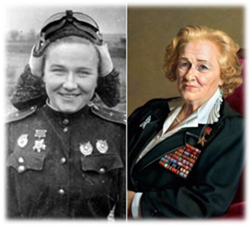

For many years she was elected to local authorities, was elected deputy of the Supreme Soviet of the USSR of the 8th convocation (1970-1974), People's Deputy of the USSR (1989-1991).
They wanted to live, to raise children
They smiled at us from pre-war pictures,
The girls fought in the clouds,
And after death they returned to the sky.
(Ilchenko Polina)
Alexandra Pavlovna Polyakova was not born in the Oryol region, but died in the Orlovschina, defending her homeland. Shura Polyakova is the only female pilot in Russian and world history who carried out a fire ram. She was 21 years old.
Alexandra, or simply Shurochka, as her family called her, was born in Borisoglebsk, Voronezh Region, in 1922.
Since childhood, she dreamed of becoming a pilot. Just before the war, the girl graduated from secondary school No. 5 of Borisoglebsk and at the same time from the aero club, and received a pilot instructor certificate.
When in June 1941 the news of the beginning of the war flew around the whole country, a nineteen-year-old girl turned to the military commissar of the city with a request to send her to the Borisoglebovsky military aviation school. The school was successfully completed, but Polyakov was not allowed to go to the front – she was left in the aviation school as an instructor pilot. For more than a year, Shura wrote letters, statements, reports to various authorities with a request to send her to the active army. She achieved it – she found herself near Stalingrad, in the midst of battles.
|
Polyakova Alexandra Pavlovna (16.04.1922 – 09.05.1943) (21 years old) Born in Borisoglebsk (now Voronezh region) |
The only female pilot in Russian and world history who carried out a fire ram. Managed to make 86 sorties, disastrous for the invaders.
She was awarded the second Order of the Red Star posthumously, she was awarded the rank of second lieutenant. |
On the night of May 9-10, 1943, Alexandra Polyakova flew to the night bombing of the railway junction of the Glazunovka station, where echelons with ammunition and manpower were concentrated. When a fragment of an enemy anti-aircraft gun shell pierced the engine of the aircraft, Shura sent her flaming car to the enemy echelons. |
Alexandra flew a U-2 biplane. This model, created by Nikolai Polikarpov, a native of the Orel region, in 1928 and renamed Po-2 in honor of the designer after his death. Po-2 was used as a training, sanitary, liaison aircraft and it fought on the fronts of the Great Patriotic War as a night bomber.
Boris Pustovalov, who during the war was a navigator of night bombers and made 300 sorties, participating in the largest battles of the Great Patriotic War, tells in his book "Those three hundred dawns ..." about what a young pilot Shura Polyakova was like. "Even near Stalingrad, in the midst of the battle, the pilot Shura Polyakova came to our regiment, short, black-haired, with a delicate blush on her cheeks, to be honest, the girl did not cause us much delight… Meanwhile, Shura flew out on a combat mission, successfully bombed out – and her hard work began. We soon felt in the character of this girl not at all girlish feature. She resolutely rejected the sparing regime proposed by the leadership, and drove a night bomber, in no way inferior to us, often making 5-7 sorties per night."
Only on the Stalingrad Front, as part of the 970th Night Bomber Aviation Regiment, Alexandra Polyakov made 35 night combat sorties.
The reports noted that "Polyakova, as a pilot, despite the presence of a large number of anti-aircraft searchlights on the approaches and in the target areas, and the heavy shelling of enemy anti-aircraft artillery, always broke into the intended target, which ensured the targeted dropping of combat cargo. The plane had shrapnel and bullet holes. Repeatedly, when performing combat missions, she got into difficult weather conditions (icing, fog, heavy precipitation), where she always made the right decisions and emerged victorious."
On January 17, 1943, Alexandra Polyakova was awarded the Order of the Red Star for her excellent performance of combat missions to destroy the German invaders on the Stalingrad Front, and for her courage and bravery.
By the spring of 1943, Alexandra Polyakova had flown 86 sorties.
During the battles on the Orel-Kursk Bulge, the front command of the 970th Night Bomber Regiment, where Polyakova served, was tasked with destroying enemy manpower and equipment on the night of May 9-10, 1943, which, according to aerial reconnaissance, were unloaded at the Glazunovka station, 65 kilometers south of the city of Orel. A group of Po-2 bombers consisting of three combat vehicles, including the crew of pilot Alexandra Polyakova, flew on a combat mission.
The task was complicated by the fact that the Glazunovka station was covered by powerful fire from anti-aircraft batteries and searchlights. But Polyakova confidently went to the goal. She saw echelons of military equipment on the tracks, trains of fuel tanks, appearing from a height as small black barrels.
Gradually descending, the girl aligns the plane with the railway line. Navigator-bombardier Sagaidakov masterfully does his job – bombs accurately fall into the intended target, fires and explosions paint the darkness of the night with bright colors. Suddenly, the plane was "grabbed" by searchlights. An anti-aircraft shell exploded nearby flew into the bomber's engine, the plane caught fire, but Alexandra decides to carry out the order at any cost and destroy the echelon going to the front.
Polyakova's comrades-in-arms, who flew out with her on a combat mission, saw how the pilot sent the plane engulfed in flames to the enemy echelon. So Sergeant Alexandra Polyakova repeated the immortal feat of Captain Nikolai Gastello, committed by him on June 26, 1941. The pilot sent her downed Po-2 bomber to a cluster of enemy echelons near the Glazunovka railway station in the Orel region.
The earth literally burned at the station, ammunition exploded, fuel tanks flared up. Together with Yefim Sagaidakov, the pilot left the aircraft. Unfortunately, the crew failed to land successfully, the Hitlerite machine gunners shot the pilots.
Local residents buried the girl in the forest near the place of death, near the village of Malye Bobriki, but in 1956 she was reburied in a mass grave in the village of Senkovo, Glazunovsky district, Orel region.
Материалы на данной страницы взяты из открытых источников либо размещены пользователем в соответствии с договором-офертой сайта. Вы можете сообщить о нарушении.